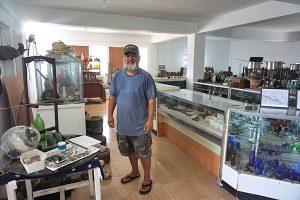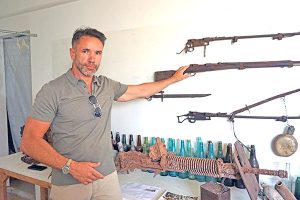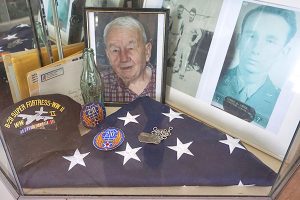Fabian Indalecio: Steward of the past
- Fabian Indalecio at his personal museum of World War II relics from the islands of Saipan and Titian. (Bea Cabrera)
- Fabian Indalecio’s friend, Vladislav Melnik, gives the war relics he finds to Indalecio to add to his collection and for safekeeping. (Bea Cabrera)
- Among the thousands of relics that Fabian Indalecio has in his collection, dog tags are what he considers his most prized possessions. (Bea Cabrera)
Going out into the fields of Saipan and Tinian to hunt for relics of World War II is not just a hobby but a way of life for Fabian Indalecio.
“My passion for history comes natural for me and I feel like I was born with it,” he said.
That passion for history and sharing them has resulted in Indalecio amassing thousands of World War II relics—and each one tells a story of pre-war, during the war, and post-war times.
He brought that passion with him when he lived in the U.S. mainland, collecting old and vintage stuff like stamps, coins, etc. by combing through flea markets for a rare find.
“When I came back to Saipan in 1992, I continued the passion but, this time, no more flea markets for me,” he said.
He collects not just anything, though. Indalecio is very specific, his collection consisting mostly of U.S. and Japanese relics from World War II.
“If these things were not saved, it will just disintegrate, with the exception of the bottles and glass. …Right now, everything is just getting to a point that many relics are missing and lost because many lands are being taken over, bulldozed, and cleared. That makes it hard to find and recover war relics,” he added.
His collection is meticulously displayed in a house in San Antonio, which he opens to anyone who is interested to know more about the Battle for Saipan.
“It’s not an official museum but a place for my personal collection. …I open it up to anybody.”
The more people come to see the relics, the happier he is, such that he forgets all the time, effort, and hard work he has already put into looking and digging up these artifacts.
“I really love history and I realized that sharing with everyone—especially with the younger generation and war veterans that come to Saipan what I find in the caves, jungle, and mountain trails—is where true joy really comes from,” he said.
The diversity of his collection is truly wide-ranging. They are arranged and identified on which island the relics came from. From weapons, gear, and airplane parts, to personal hygiene items and belongings that were sentimental to the owner. “We found a photo of a woman intact in a clear casing with her name written at the bottom of the photo…we found combs, shaving paraphernalia, medicine bottles, eyeglasses, etc. that just [teaches] you that these soldiers were also ordinary people like us,” he said.
“Sometimes, when I think about what these people went through…I wish that we could connect to them so that that they can either have the item back or at least know that they’re appreciated and respected,” he added.
Among the thousands of relics in his collection, his most prized possessions are the name tags or dog tags of the soldiers. “We found the dog tag of Donald A. Deeds and I was able to get in touch with him. We communicated through letters and Facebook and he was a gentleman and very shy,” he said.
“I was trying to return it to him but the son who I also communicated with said it is okay and that I should take care of it. Deeds passed away a couple of years ago when he was 92 years old and I am glad before he died that we were able to thank him for all the things that he has done for our islands,” Indalecio said.
Whenever he goes out to the jungle, he does it with intention. “I do my research, read maps to determine sites and the same process after I retrieve relics. There is also a responsibility involved when you retrieve them; otherwise those relics would be meaningless,” he said.
“As for safety, especially when I find explosives, I assess the condition and report it to the Department of Public Safety. When somebody brings [World War II explosives] to me, I redirect them to DPS as they clean those, take it to Marpi, and have the Navy ordnance come over here and get rid of the explosives,” he added.
Indalecio’s friend, Vladislav Melnik, is a fan of his collection. “His collection is amazing and I’m very happy to meet this guy as we share this passion. As a former Army guy, we understand each other and whenever I retrieve relics from my hikes I give them to Fabian to add to his collection,” he said.
“I’m glad the things that I find has somewhere meaningful to go to,” he added.
Indalecio said these relics in his personal museum is like a big family. “It’s hard to kind of break it apart, like bring some here and there. I hate to sound greedy but if someone took some of them and separated it from the pack, then it is as if it was separated from [its] family.”
“Not everything here is found by me. Some relics come from people who donated and entrusted them to me for safekeeping. I also solicit and pay for them but when it reaches this place, its value becomes zero because everything in this museum is not for sale,” he added.
Now 58 years old, Indalecio has been retrieving and collecting war relics half of his life. “I have slowed down but I am not planning to stop as the passion of collecting will forever remain in me. …Peter Camacho Muña, who is like my own son, will carry on the legacy of protecting these pieces. He is now serving in the U.S. Army and he is very knowledgeable, respectful, and passionate about history and he is a better tour guide than I am.”
“These relics are the legacies of the people that died for our islands. For my part, I want my legacy to be one of the people that protected their memories because they are…never forgotten,” he added.
“There are lot of people who died for this island and for the Marianas. …By safeguarding these relics, it is my way of paying my respect to [them].”


























